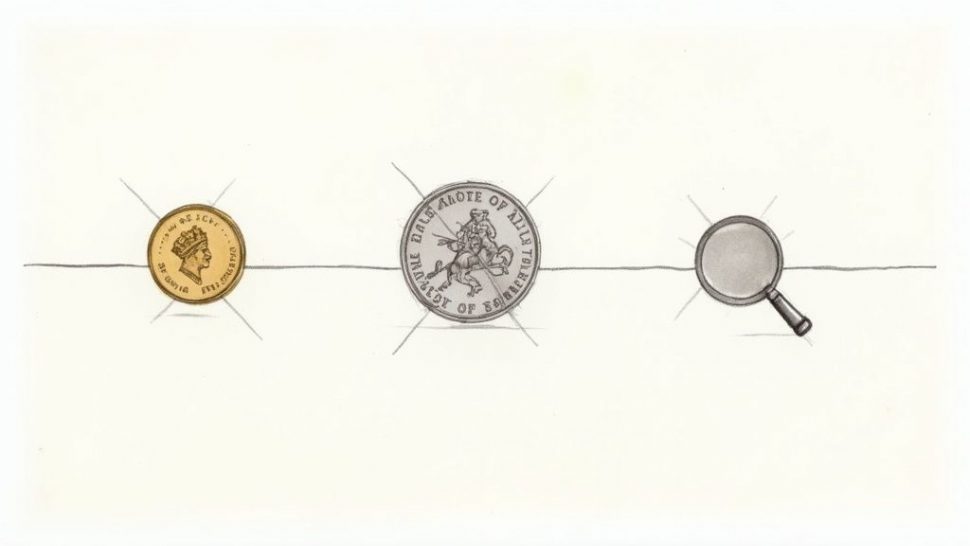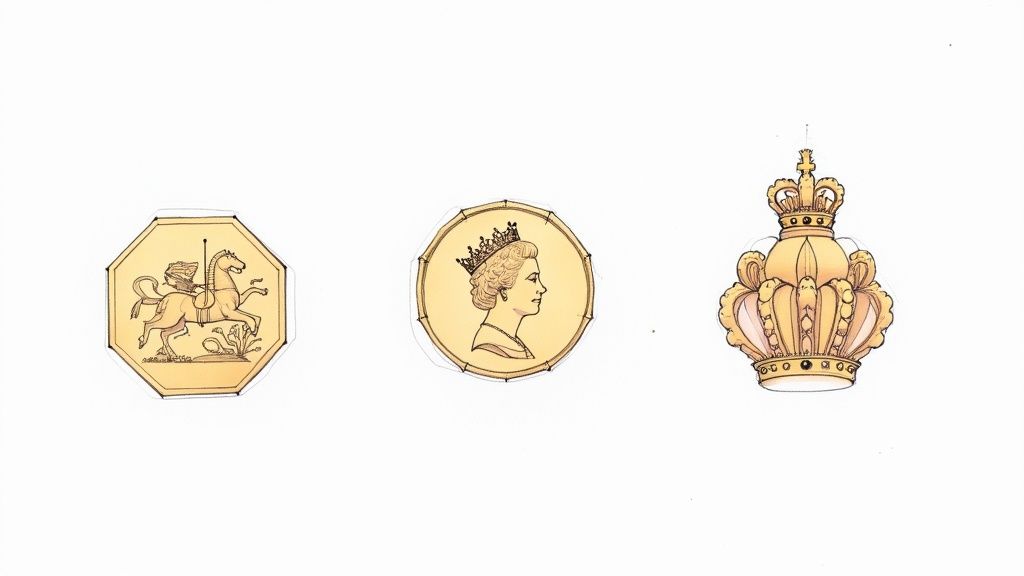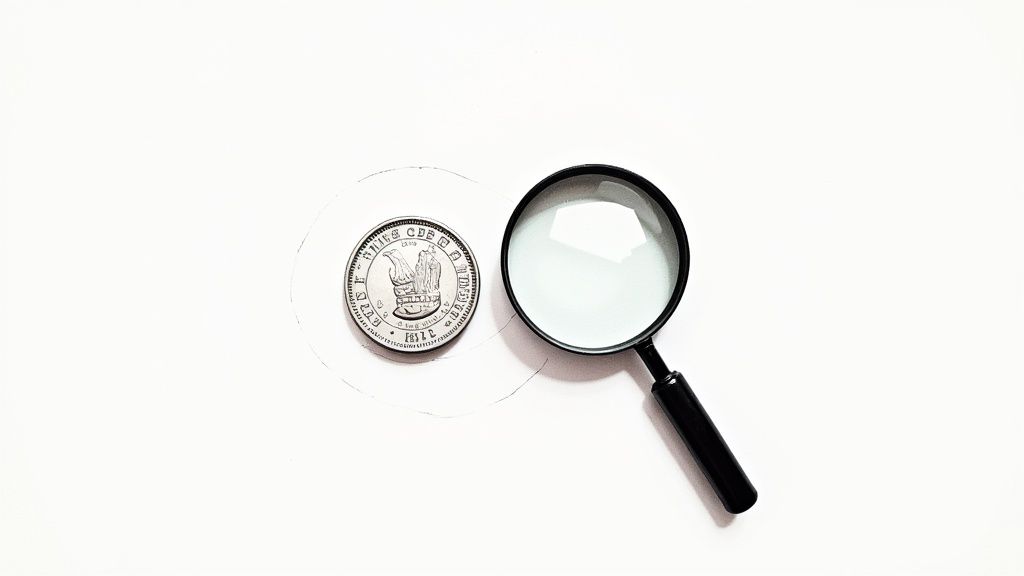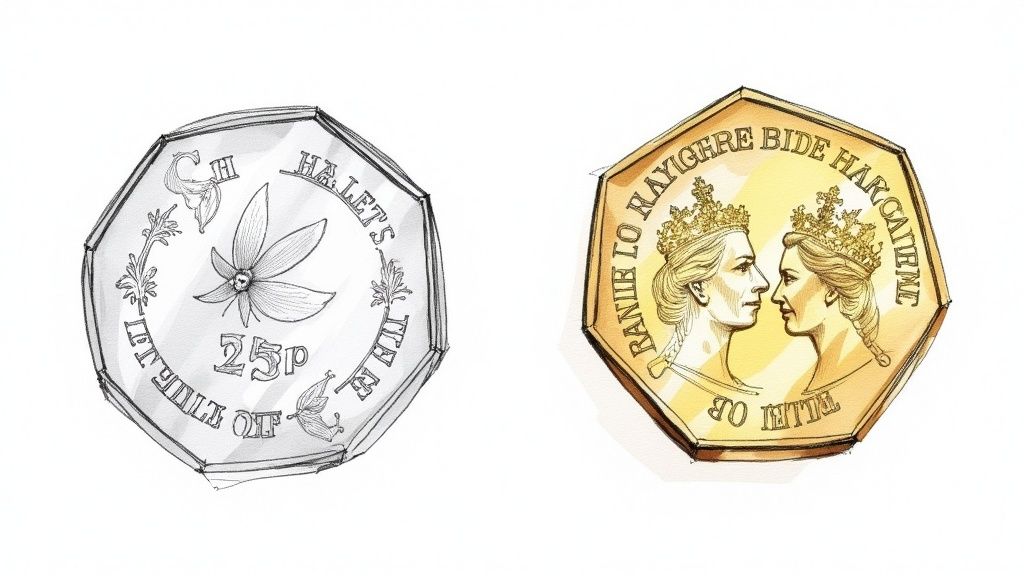A Guide to British Crown Coin Values

Posted by: Ian • 13 Oct 2025
When you find an old British crown coin, it feels like you're holding a real piece of history. But the big question is, what's it actually worth? While some rare, early silver examples can be quite valuable, most modern British crown coins are worth more for their collectability than any precious metal they contain. This guide will help you tell the difference and figure out what to do with them.
The Enduring Legacy of the British Crown
The story of the British crown spans nearly 500 years, starting life as essential currency before becoming the commemorative coin we know today. It can be a bit confusing to identify what you have. Is it a five-shilling piece, a 25p coin, or a £5 issue? Figuring that out is the first step to discovering its true value.
For many of us, these coins are just part of a bigger, jumbled collection of leftover holiday money or old currency passed down from a relative. The thought of sorting through it all can feel overwhelming, especially if you’re not sure what to look for. That's where a simple, no-fuss exchange service really comes in handy, offering a fast, easy, and hassle-free way to convert foreign coins and banknotes.
From Circulation to Commemoration
The British crown's journey started way back in 1526 under King Henry VIII. It was originally a gold coin with a value of five shillings, but from 1551 it was minted in sterling silver to make it more durable – a standard that stuck around for centuries. This history is key, as it's why the older, silver crowns often have a higher intrinsic value.
As Britain’s currency system changed, especially with decimalisation in 1971, the crown's role shifted. It went from being a workhorse coin used in daily life to a popular commemorative piece, usually released to mark major royal events like the Queen's Silver Jubilee in 1977. You can learn more about the popular Queen Elizabeth II Silver Jubilee 1977 crown and its value.
This image helps break down the main types of British crowns you might come across.

As you can see, the coin’s path split over time, moving away from everyday circulation and towards modern commemorative issues. It also shows how easy it is to exchange mixed collections that contain these coins.
What to Do with Your Coins
While a handful of crowns are rare and valuable, the vast majority are common issues that hold more sentimental than monetary worth. If you have a jar of these mixed in with leftover foreign currency or old banknotes, our fast and easy exchange service is the perfect solution.
We're trusted by major UK brands including charities, supermarkets, airports, and even police forces. We offer a 100% guaranteed way to convert your foreign coins and notes without you needing to sort through them first. It’s a completely hassle-free way to turn that forgotten currency into cash.
How to Identify Your Crown Coin's Era
Before you can figure out what your crown is worth, you need to play detective. The first and most important clue is the monarch's portrait on the front (the obverse). This tells you the era it belongs to, which is the essential first step in getting an accurate idea of its value.
Think of it like dating antique furniture. Knowing if a chair is Georgian, Victorian, or Edwardian instantly gives you a sense of its style, construction, and potential worth. It's the exact same principle with crowns. Each period has its own story, metal content, and design quirks that collectors and valuers look for.

To get you started, here’s a quick overview of the key periods you're likely to encounter.
Key British Crown Coin Eras at a Glance
| Era | Reigning Monarchs (Examples) | Typical Metal Composition | Common Reverse Designs |
|---|---|---|---|
| Pre-Victorian (1818-1837) | George III, George IV, William IV | 92.5% Sterling Silver | St. George and the Dragon, Crowned Shield |
| Victorian (1837-1901) | Queen Victoria | 92.5% Sterling Silver | Crowned Shield, St. George and the Dragon |
| Early 20th Century (1902-1946) | Edward VII, George V, George VI | 92.5% Silver (until 1919), 50% Silver (1920-1946) | St. George and the Dragon, Various Wreaths |
| Late 20th Century (1947-1965) | George VI, Elizabeth II | Cupro-Nickel (No Silver) | Commemorative designs (e.g., Festival of Britain) |
This table should help you quickly narrow down the period your coin comes from, but let's dive into the details for each era.
Pre-Victorian Crowns: The Silver Classics (1818-1837)
The story of the modern crown really kicks off after the Napoleonic Wars, with the first UK-era coin struck in 1818 under George III. These early crowns are the ones collectors get genuinely excited about, and for good reason. They combine high silver content with absolutely beautiful artistry.
Minted from sterling silver (92.5% pure), these coins carry a hefty intrinsic value just from the metal alone. But what makes them truly special is the iconic reverse design of St. George and the Dragon by Benedetto Pistrucci—a masterpiece so timeless it’s still used on British sovereigns today.
If you have a pre-Victorian crown, especially one in decent shape, you almost certainly have a valuable coin. The blend of precious metal, rich history, and classic design makes this a standout category for any collector.
The Long Reign of Queen Victoria (1837-1901)
Queen Victoria was on the throne for so long that her coinage is a collecting field all by itself. Her crowns are fascinating because they literally show her ageing, from a young queen to a matriarchal empress. Figuring out which portrait your coin has is the key to dating it.
There are three main portraits to watch for:
- The Young Head (1839-1887): Features a youthful portrait of the Queen. The earliest crowns from this period are incredibly rare.
- The Jubilee Head (1887-1892): Issued to celebrate her Golden Jubilee, this shows a more mature Victoria wearing a small crown.
- The Old Head or Veiled Head (1893-1901): Her final portrait depicts the Queen as a widow, veiled and in mourning.
From 1801 right up to 1967, the crown was a cornerstone of British currency, worth five shillings—a quarter of a pound. While the dramatic St. George design was common on early 19th-century crowns, this was replaced during much of Victoria’s reign with a more formal crowned shield inside a wreath. It did, however, make a popular return on her later issues. You can explore more historical insights about UK crown coin values.
20th Century Pre-Decimal Crowns (1902-1965)
The 20th century was a time of huge change for the crown. It was still a large, impressive coin, but its purpose and what it was made of started to evolve. Crowns were minted for Edward VII, George V, George VI, and in the early years of Elizabeth II's reign.
The single most important change was the metal. Until 1919, crowns were still sterling silver. But from 1920 to 1946, the silver content was slashed to just 50%. After 1947, they were struck in cupro-nickel, which contains no silver at all. This is crucial for value: a 1937 crown has silver value, whereas a 1951 'Festival of Britain' crown does not.
These later crowns were often minted to mark special occasions and were the last ones intended for potential circulation before Britain went decimal. Knowing the year is everything when it comes to understanding its base value. If you have a mix of these coins and other leftover foreign currency, remember our service is designed to be fast and easy—with no need to sort anything yourself.
Determining Your British Crown Coin Value
So, you've figured out which era your crown coin comes from. What's next? The real detective work begins now, as you start to understand what separates a common keepsake from a genuinely valuable find. It’s not just about age; several key factors come together to determine a coin's worth.
Think of it like appraising antique furniture. A mass-produced, heavily-used chair from the Victorian era has a very different value to a rare, beautifully preserved piece from the same workshop. The same logic applies directly to British crown coin values. Originality and condition are everything.

Let's break down the four critical factors that tell you what your coin is really worth.
Monarch and Year The Foundational Clues
The first two things to look for are the monarch's portrait and the date. This combination is your starting point, giving you immediate clues about the coin’s metal content and historical context. As we've covered, a crown from 1937 is 50% silver, whereas one from 1951 is made of cupro-nickel and contains no precious metal at all.
This first check helps set a baseline value. A silver coin will always have an intrinsic worth based on its metal content—its "melt value." A cupro-nickel coin, on the other hand, relies entirely on its collectability to have any value.
Condition and Grade How Well Has It Survived
A coin's physical condition, known in the trade as its "grade," is arguably the biggest driver of its final price. Even an incredibly rare coin will lose most of its value if it’s heavily damaged, scratched, or has been aggressively cleaned. Collectors want originality and sharp details.
Coin grading runs on a scale from "Poor" all the way up to "Uncirculated" or "Proof."
- Circulated Coins: These show obvious wear and tear from being used as money. The finer details might be flattened, and the surfaces will have nicks and scratches. Most crowns found rattling in old biscuit tins fall into this category.
- Uncirculated Coins: An uncirculated coin looks like it just left the Royal Mint yesterday. It shows no signs of wear, still has its original shine, and all the tiny details of the design are crisp and clear.
A common Victorian crown in heavily worn condition might be worth little more than its silver content. But the exact same coin in pristine, uncirculated condition could fetch hundreds, or even thousands, of pounds from a serious collector.
Rarity and Mintage How Many Were Made
Rarity is simple supply and demand. The "mintage" is the official number of coins the Royal Mint produced in a specific year. A coin with a very low mintage is naturally harder to find, which makes it far more desirable.
For example, the 1953 crown for Queen Elizabeth II's coronation had a huge mintage of nearly 6 million, making it extremely common. You can learn more in our guide on the value of a 1953 five shilling coin to see how that number affects its price. By contrast, some early Victorian crowns had mintages under 100,000, making them significantly scarcer and more valuable today.
When looking at your collection's potential, it's useful to understand how to calculate the return on investment to get a clearer financial picture of these rare finds.
Errors and Varieties The Unique Imperfections
Every now and then, mistakes happen during the minting process. These "errors" can create unique and often valuable varieties that collectors actively hunt for. While major errors on crowns are unusual, they can include things like:
- Off-centre strikes: The design isn't perfectly centred on the coin blank.
- Die cracks: A crack in the metal die leaves a raised, zig-zag line on the finished coin.
- Mules: A very rare and exciting error where a coin is struck with an obverse and reverse die that were never meant to be paired together.
Finding a genuine error coin can dramatically increase its value. But a word of caution: many coins with apparent flaws are just the result of damage that happened after they left the mint, which actually detracts from their worth.
Ultimately, if you have a big, mixed collection of coins—whether it’s crowns, old British money, or leftover foreign currency—trying to value each one can feel like a mammoth task. For a fast, easy, and hassle-free solution, our exchange service is the perfect answer. We are trusted by charities, airports, and supermarkets, offering a 100% guaranteed service with no need to sort your coins first. It’s the simplest way to convert foreign coins and banknotes into cash.
The Modern Shift to Commemorative Crowns
If you've ever stumbled across a big British crown coin dated after 1965, you might be a bit puzzled. Wasn't decimalisation supposed to be the end of the old five-shilling pieces? Well, you're right, but the crown’s story didn't stop there—it just took a different path. It transformed from a coin in your pocket to a national keepsake.
This change marks a clear dividing line in British crown coin values. Before 1965, crowns were part of the circulation. After that, they became something else entirely: a way to celebrate Britain’s most important moments. Grasping this evolution is the key to setting realistic expectations for any modern crowns you might own.

The Birth of the 25p Crown
The crown’s life as everyday money officially ended when Britain switched to a decimal system in 1971. After this huge shift, the coin was reborn. Its old five-shilling value became equivalent to 25 new pence, and The Royal Mint started issuing commemorative '25p crowns' purely as souvenirs. These coins, often released for major royal events, were produced in massive quantities.
Take the 1977 Silver Jubilee crown, for example. Millions were given to schoolchildren to mark the occasion. Because they were made in such huge numbers, they aren't rare, so while they hold plenty of sentimental value, their financial worth is usually quite low.
While modern crowns are technically legal tender, their real value is almost never tied to their face value. Instead, it comes from either their collectability or, in the case of special proof editions, their precious metal content.
From 25p to the Modern £5 Crown
The story took another turn in the 1990s. To keep up with inflation and better reflect its special status, the face value of new commemorative crowns was bumped up from 25p to £5. This tradition continues today, with The Royal Mint releasing crown-sized £5 coins for big national and royal events, from milestone birthdays to historic anniversaries.
This change cemented the crown’s position as a collector's item. Although a modern crown might say "Five Pounds" on it, you’d be incredibly unlikely to ever get one back as change from the shops. They are made almost exclusively for the collector market.
What Does This Mean for Your Coins?
Understanding this modern history is vital. If you have a collection with crowns from 1972 onwards, it explains why they feel different from the older silver pieces. They were simply made for a different purpose. Their value is driven by factors like:
- Precious Metal Content: Do you have a standard cupro-nickel version, or a limited-edition silver or gold proof?
- Original Packaging: Collectors will often pay a premium for coins still in their original Royal Mint presentation box with a certificate of authenticity.
- Popularity of the Event: Coins marking incredibly popular events, like a major royal wedding, can sometimes attract more interest.
For most people, these modern crowns are just part of a larger, mixed bag of old coins and leftover foreign currency. Trying to sort through them to spot the valuable proofs can be a real chore. That's why our service is designed to be fast, easy, and completely hassle-free.
We are trusted by major brands—including charities, supermarkets, airports, and police forces—to exchange foreign coins and notes. There’s no need to sort anything; just send us your collection, and we’ll provide a 100% guaranteed valuation. It's the simplest way to convert foreign coins and banknotes, whether you want to cash them in or donate foreign coins to charity. Ready to get started? Visit our homepage to see how easy it is.
So, What Can You Do With Your Coins?
After diving into the fascinating history of British crowns, you might be looking at your own collection and wondering what to do next. What about the coins that aren't rare collector's items? Maybe you have a few common Churchill crowns, a handful of old shillings, or even a bag of mixed foreign coins from holidays past. Trying to figure out the value of each one and sell them individually can feel like a massive chore.
This is where a different kind of value comes into play: the value of your time and convenience. Instead of spending hours sifting through piles of coins, you can turn that entire unsorted collection into cash, quickly and without any stress. Our service is designed to do just that.
The Easiest Way to Convert Your Old Currency
We offer a fast, simple, and completely hassle-free way for anyone looking to exchange old coins and banknotes. The best part? There’s absolutely no need to sort anything. Just gather up all your leftover currency—whether it's British crowns, old decimal coins, pre-euro notes, or any other foreign money—and send it to us.
We take care of all the sorting, counting, and valuing for you. Our whole process is transparent and designed to give you complete peace of mind.
Our service is 100% guaranteed, offering a simple and credible way to convert your leftover currency into cash. It’s the most practical way to get value from coins that aren’t high-grade collectibles destined for a specialist auction.
A Service Trusted by Major UK Brands
Building trust is at the very heart of what we do. We’re proud to be the currency exchange partner for some of the UK’s most recognised organisations, which shows just how reliable our service is. Our long-standing relationships include:
- Major UK Charities: We help them turn currency donations into essential funds for their causes.
- Supermarkets and Airports: We manage the currency collected in their public donation boxes.
- Police Forces: We're the trusted service for handling currency recovered during official duties.
This network of trusted partners highlights our commitment to providing a professional and dependable service. When you choose us, you're choosing a company that major brands rely on every single day.
Turning Clutter into Cash or Donations
Whether you're looking to exchange foreign coins, clear out currency you've inherited, or simply convert foreign coins and banknotes into money you can actually use, our system is built for simplicity. We also offer a straightforward way to donate foreign coins to charity, letting you support a good cause with your leftover change. You can find out more in our guide on the easy way to exchange old British coins and notes.
Forget the headache of sorting through piles of unidentified coins. Let our expert team do the heavy lifting. We provide clear, competitive rates and make sure you receive your payment promptly.
Ready to get started? Visit our homepage to see just how easy it is to turn that forgotten currency into something valuable. Our fast, secure, and hassle-free service is the perfect final step on your coin-valuing journey.
Your Crown Coin Questions Answered
Now that we've journeyed through the fascinating history of the British crown, from its silver origins to its modern commemorative issues, you probably have a few practical questions. What should you do with that old coin you found in a drawer? This section tackles the most common queries head-on.
Think of this as your go-to guide for those final "what if" questions, giving you clear, straightforward answers.
Are All British Crown Coins Made of Silver?
This is the number one question we get, and the short answer is no. The metal content of crowns has changed dramatically over the years, which is the biggest factor in their base value. Getting the timeline right is key.
For centuries, crowns were made from sterling silver, which is 92.5% pure silver. That all changed in 1919. After that, the recipe was tweaked twice for coins meant for circulation:
- 1920 to 1946: The silver content was chopped down to just 50%.
- 1947 onwards: All circulating crowns were switched to cupro-nickel, a metal alloy with no silver at all.
While The Royal Mint still produces special silver or gold proof versions for collectors, the overwhelming majority of crowns you'll find from the last 70 years or so aren't made of precious metal. The date on the coin is your best clue to what it's made of and its basic British crown coin values.
What Is My 1965 Churchill Crown Worth?
The 1965 Winston Churchill Commemorative Crown is probably the single most common crown coin stashed away in homes across the UK. A staggering 19 million of them were minted, so they are anything but rare.
Because it's made of cupro-nickel (not silver) and is so easy to find, a standard Churchill crown has very little cash value. Most sell for just £1 to £2 to a casual buyer. It’s a wonderful piece of history and a great tribute to a national hero, but its value is more sentimental than financial.
If you have a few of these mixed in with a larger, unsorted pile of old money or leftover foreign currency, our service is the perfect fit. We offer a fast, easy, and hassle-free way to turn it all into cash without you having to sort through it first.
How Do I Sell My Crown Coins or Donate Them?
The best route for selling your crowns really depends on what you've got. The advice for a rare, high-quality silver coin is completely different from what you'd do with a common, worn-out one.
If you're lucky enough to have a very rare, early silver crown in fantastic condition, your best bet is a specialist coin dealer or a numismatic auction house. They have the expertise to grade it properly and find serious collectors who will pay top price.
But for everything else—common crowns like the Churchill one, circulated coins showing their age, or mixed bags of old British and foreign currency—our service is the simplest, most practical choice. We make it easy to exchange foreign coins and notes for cash.
You can also use our service to donate foreign coins to charity. Simply send us your collection, and we can direct its value to one of our major UK charity partners. Our process is 100% guaranteed and trusted by major brands, taking all the sorting and hassle off your hands.
Does a Damaged Crown Coin Have Any Value?
Yes, even a damaged coin can be worth something, but its condition has a massive impact. Collectors want coins in their original state, so things like deep scratches, harsh cleaning, dents, or holes will dramatically lower a coin's appeal and its price.
But a damaged coin isn't automatically worthless. It all comes down to what it's made of:
- Silver Crowns: A damaged silver crown still has its "melt value" or "scrap value." This is the value of the actual silver inside it, based on current market prices for silver bullion.
- Cupro-Nickel Crowns: A damaged cupro-nickel crown, on the other hand, has almost no monetary value. Its worth is tied entirely to its collectability, and significant damage wipes that out.
If you have a jumble of coins in all sorts of conditions, our exchange service is the ideal way to get value from the whole lot. It’s a fast and easy process where you don't need to worry about the state of every single coin. We handle everything, giving you a completely hassle-free experience.
At We Buy All Currency, we specialise in turning your forgotten and unsorted currency into cash. Our service is trusted by major brands, including charities, supermarkets, airports, and police forces, because it is fast, easy, and completely secure. Don't let that old collection of crowns and foreign coins gather dust—let us convert it into something useful for you.
Ready to clear out your clutter? Visit our homepage to learn how you can exchange foreign coins and notes today.
